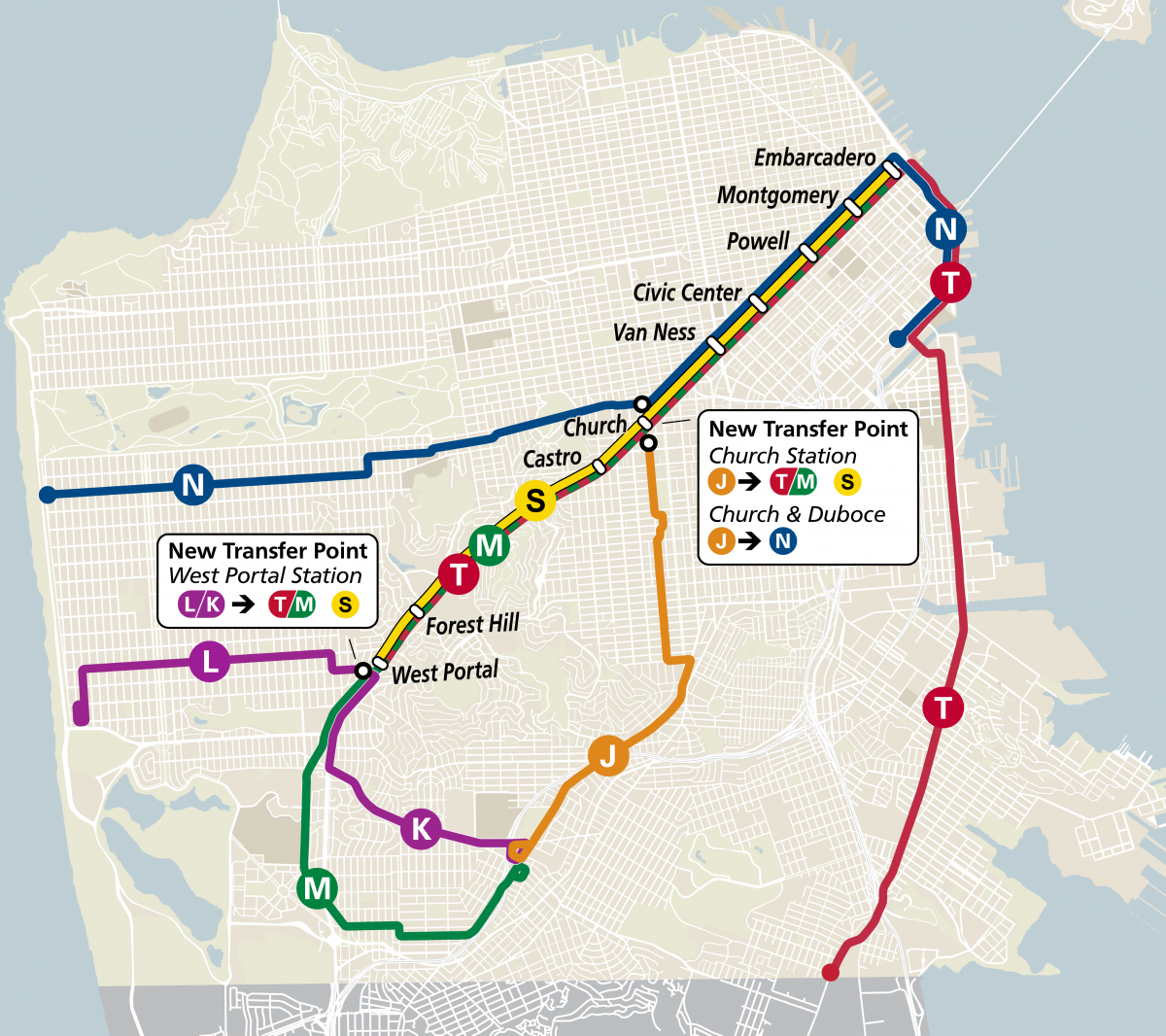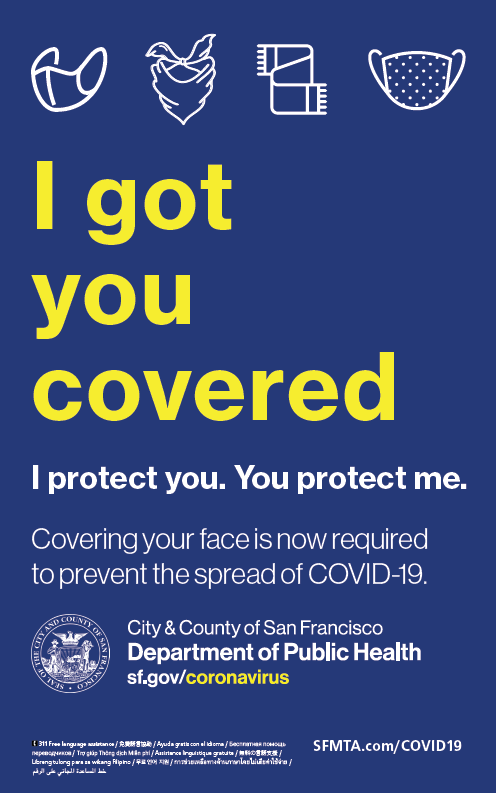Jumat, 10 Juli 2020
Show HN: Calla Chat https://ift.tt/2Od3qPz
Show HN: Amna - a information manager that helps get work done https://ift.tt/31ZsFwG
Return of Muni Metro Rail FAQs
By Mariana Maguire

Map: Proposed new Muni Metro rail configuration.
Recently, we shared the exciting announcement that Muni Metro Rail service will return in August with some time saving changes. For some customers, this is a big change and we know there are lots of questions! So, we complied answers to some of the most frequent ones we hear.
Stay tuned for more information as we prepare to deliver more reliable, efficient rail service back to San Francisco. And please remember that Muni is still for essential trips only. You can help reduce crowding on transit by using other transportation options if they are available to you, like walking, biking, or our Essential Trip Card program. Unless you need to take transit for work, stay local and support your neighborhood businesses as they reopen.
How are Muni Metro Rail routes changing and will any routes be eliminated?
None of the Muni Metro rails lines are being eliminated. Rail service is returning in full, with some changes to the configuration to fix the chronic delays caused by our overburdened single subway tunnel where all the lines converge.
- The L Taraval and K Ingleside surfaces lines will be combined into one line referred to as the LK. This means the L Taraval will still run from the SF Zoo to West Portal Station, where it will continue as the K Ingleside to Balboa Station via Ocean Avenue. The K Ingleside trains will do the same, running towards West Portal from Balboa Station before continuing on the L Taraval line to SF Zoo.
- Customers on the LK heading towards downtown can transfer to the S at West Portal or to the TM at Saint Francis Circle.
- The J Church will continue to run from Balboa Park Station to Church and Market but will terminate at Church and Market and turn around instead of entering the subway. Customers heading downtown can transfer to the TM or S in the subway or other above ground transit nearby.
- The M Oceanview and T Third will now be combined from West Portal to Embarcadero.
We are currently safety testing three-car trains for the S Shuttle running from the Embarcadero to West Portal Station.
As a result of these changes, we expect customers will experience much more reliable and efficient service with far fewer delays along each leg of their trip.
Where will the transfer points be?
With the new temporary rail configuration, customers on the L Taraval or the K Ingleside continuing downtown will transfer at West Portal Station to the new all-day S Shuttle that will operate exclusively underground from West Portal to Embarcadero.
LK customers can also transfer to the TM line at West Portal Station to get downtown. This configuration will reduce delays and congestion in the tunnels, making service more reliable throughout the rail system.
For those who want to minimize the distance between transfer points St. Francis Circle is a great place to switch between the LK and the TM. This stop has accessible ramps inbound and outbound that serve both the LK and the TM.
J Church customers continuing downtown will transfer at Church and Market to the subway.
We expect fewer delays at these transfer points because trains will no longer suffer chronic back-ups from subway congestion.
Will transfer points be accessible?
Yes. We are currently working on two capital improvement projects to facilitate our proposed new rail configuration – the West Portal LK Transfer Project, and the J Church Transfer Improvements Project. The goal of these projects is to make the new transfers accessible. Project teams are working with local communities to test the placement and design of accessible ramps at Ulloa and updates at Market and Church. St. Francis Circle, another transfer point for the LK, also has accessible ramps.
As always, please plan some extra time when riding Muni – buses or rail – for unexpected situations and to allow for physical distancing requirements.
Will there be wayfinding signs and outreach to help customers understand the changes?
Yes. We are developing new subway maps and wayfinding signs. We will post knowledgeable ambassadors at transfer points and key stops to help direct customers. We will also install information inside our buses and trains before and after rail service restarts, and new onboard announcements will remind customers of the new transfers points.
Other outreach includes:
- Sending multilingual mailers to residents near the L Taraval, K Ingleside, J Church lines and citywide;
- Working with merchant groups, community-based organizations, Supervisor offices and neighborhood associations to get the word out among diverse communities;
- Offering public presentations on the Transfer Improvement Projects and temporary rail changes;
- Placing multilingual ads in citywide and neighborhood newspapers, TV and radio in multiple languages;
- Emailing customers who signed up for updates on our projects;
- Social media campaigns.
How can the public provide input?
The new rail configuration and the related Transfer Improvements Projects at West Portal and Church & Market are temporary. The goal is to identify permanent solutions to chronic subway delays and make Muni Metro more reliable, both inside the subway and on the surface. We plan to implement the new configuration and test its effectiveness. As always, customer feedback will be a key consideration in our decision making.
Public Meetings: The West Portal LK Transfer Project will host a public meeting on July 18 during which the public will have the opportunity to provide comment. Be on the lookout for a similar meeting to be scheduled for the J Church Transfer Improvements Project. These are capital projects, which require formal public input.
We have heard feedback from customers about the inefficiency of the subway, delays getting trains through the tunnels, and the need to improve reliability of Muni Metro rail. As we try out the new configuration, we will continue to take customer feedback into account, as well as ridership data, and delay statistics. To share your feedback as temporary rail changes roll out please email SFMTA.com/Feedback.
Why are these changes necessary?
Unlike many major cities, San Francisco’s subway has been over capacity with six rail lines trying to use one tunnel that can only accommodate turnarounds at the end points. Just like on a highway or roadway, as more vehicles use the space, the space becomes crowded and vehicles can’t move.
We temporarily suspended rail service due to COVID-19 health concerns and related staffing shortages. Now that we have a mobile cleaning program and more operators back at work who are certified to operate Muni Metro light rail vehicles, we can restore rail service in full. By trying out a new configuration of rail service, we expect to reduce the long delays that customers used to experience, stuck at or between stations.
Does this mean more people will be able to ride the trains during COVID-19?
Customers must still adhere to citywide physical distancing guidelines while riding Muni Metro rail. And, face coverings are required to ride Muni and while waiting at stops.
We are working with experts at the San Francisco Department of Public Health to add capacity to our vehicles as appropriate.
How often will trains run and what’s the schedule?
Trains will run seven days per week at frequencies of ten minutes or less. We are coordinating scheduling details and will release more information before the August service changes go into effect.
Now that you’ll have more buses available, what other routes will be coming back?
We expect several bus routes to come back in August along with the return of Muni Metro rail.
By bringing back rail we can:
- Repurpose our buses for more routes
- Put our longer buses into service on different routes to reduce crowding where there is high rider demand
- Improve route frequencies on many lines so customers don’t have to wait as long for a less crowded bus
- Use our resources more effectively
We are finalizing the details of each route that will come back into service and will provide a complete list of those updates soon.
Will customers still be required to wear face coverings?
Yes. Every customer is required, by the Mayor’s order, to wear face masks in public – including while riding Muni and waiting for a Muni vehicle.
Public health information is increasingly showing that widespread and consistent use of face coverings reduces the spread of COVID-19. We urge customers to take this seriously and have instructed our operators to pass up customers who are not wearing face coverings at Muni stops.
Remember: your face covering or mask protects others, and theirs protect you.

Published July 10, 2020 at 02:22AM
https://ift.tt/3ef2lkO



